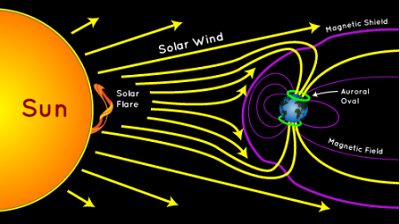Context-
On Friday night, people across the globe witnessed a rare spectacle: vivid aurorae displayed like curtains of light in the sky. These aurorae appeared in locations not typically known for such displays, such as the Indian Astronomical Observatory in Hanle, Ladakh.
The solar events that cause them can have significant negative impacts on Earth, including blackouts, satellite malfunctions, risks to astronauts, and disturbances to space weather throughout the Solar System. Hence, studying, understanding, and predicting these phenomena is a critical objective of solar physics research.
The Science Behind Aurorae
1. Role of solar storm-
The Sun sends more than just heat and light; it also emits energy and small particles. Earth's magnetic field protects us from most of this. However, the Sun’s energy output isn’t constant. Besides the steady solar wind, there are solar storms. One type, a coronal mass ejection, releases a massive bubble of electrified gas that speeds through space.
When a solar storm heads our way, some energy and particles travel along the magnetic field lines at the poles into Earth's atmosphere. These particles interact with atmospheric gases, creating stunning light displays known as aurorae.
2. The role of sunspot-
These storms are rare, typically occurring once every few decades. Both events coincided with the Sun nearing the peak of its solar cycle—an 11-year period during which the Sun’s magnetic field reverses.
During the solar cycle peak, the magnetic field flip leads to the formation of magnetically active regions on the Sun’s surface known as sunspots. These sunspots grow and shrink as the solar cycle progresses. The charged particles that reached Earth on May 10 originated from activities in these sunspots. It is becoming more active, especially compared to the last solar cycle.
In the previous solar cycle, spanning the 2010s, no sunspot activity resulted in a geomagnetic storm as intense as the recent one.
The Emergence of Sunspot AR 3664
Since early May, scientists have been closely monitoring sunspot AR 3664. By May 7, it had grown to 16 times the width of Earth and was filled with magnetic energy. Supercharged magnetic fields in such sunspots can rapidly disconnect and reconnect, releasing massive bursts of energy and sending plumes of charged particles, known as coronal mass ejections (CMEs), into space. On May 10, three CMEs struck Earth, accompanied by solar flares—powerful bursts of radiation.
The Impact of Solar Storms
● Geomagnetic storms can cause fluctuations in Earth’s magnetic field, sending surges of current through power lines ( potential power disruptions), as occurred in Sweden and South Africa in 2003.
● The May 10 storm, categorized as severe by CESSI, caused only minor disruptions to power grids and GPS systems. In countries like New Zealand, power grid operators preemptively shut off local circuits to prevent outages, demonstrating the value of early warnings.
● These storms also pose a risk to satellites, which are crucial for communication and GPS navigation. Airplanes and ships using low-frequency signals are affected by solar activity.
● Some scientists speculate that migrating animals which use magnetoreception to navigate, such as birds and honey bees, might also be affected.Example: "Smashes" occur when few pigeons return home during geomagnetic storms.
● Rapidly fluctuating geomagnetic fields can produce geomagnetically induced currents in pipelines, causing multiple problems for pipeline engineers. This can result in erroneous flow information from pipeline flow meters and dramatically increase the corrosion rate of the pipeline.
● Very high-energy particles, such as those carried by Coronal Mass Ejections, can cause radiation poisoning to humans and other mammals.
The Role of Aditya-L1 and Future Monitoring
● Space scientists aspire to predict solar storms before they begin. Currently, the best they can do is detect CMEs and flares as they occur.
● Several spacecraft monitoring the Sun are stationed at the L1 point, located about 1.5 million kilometers in the Earth-Sun direction, providing an uninterrupted view of the star. Among these spacecraft is the Indian Space Research Organisation’s (ISRO) Aditya-L1, which reached L1 in March this year.
● The principal investigator of Aditya-L1’s primary instrument, the Visible Emission Line Coronagraph (VELC), informed us that it is still being calibrated and has not yet provided data on the recent events.
● However, other instruments onboard have captured significant data. On May 14, ISRO reported that the ASPEX payload detected an increase in alpha particle and proton flux in the solar wind, indicating the solar storm’s presence.
● Additionally, the SoLEXS and HEL1OS payloads identified multiple X- and M-class flares in recent days.
● The Chandrayaan-2 orbiter around the moon also detected signatures of the solar emissions.
Conclusion
Solar storms and the resulting aurorae are both awe-inspiring and potentially hazardous. Understanding these phenomena is crucial for mitigating their impacts on Earth’s technology and infrastructure. The recent geomagnetic storm highlights the need for continuous monitoring and early warning systems to protect against future solar activity. As solar physics research advances, the goal remains to predict these storms before they begin, ensuring better preparedness for their potential consequences.
|
Probable Questions for UPSC Mains Exam- 1. How do solar storms, particularly coronal mass ejections (CMEs), impact Earth's technology and infrastructure, and what measures can be taken to mitigate these effects? (10 Marks, 150 Words) 2. What advancements are being made in solar physics research to improve the prediction and monitoring of solar storms, and how do missions like ISRO's Aditya-L1 contribute to these efforts? (15 Marks, 250 Words) |
Source- The Hindu







